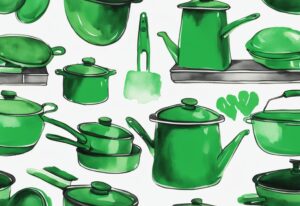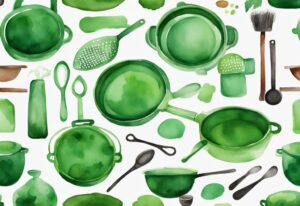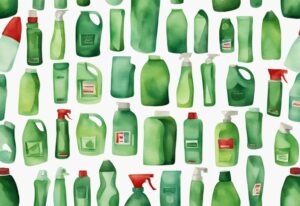Discover the Truth: Is Figment Cookware Non Toxic? Your Safe Kitchen Guide
Ever wondered about what’s hiding in your cookware? I know I did, especially when I came across Figment cookware’s promise of non-toxic cooking. But can we truly rely on these claims?
In this article, we dissect Figment cookware from all angles—its materials, features, and benefits—to clear any uncertainties.
Join me on this trip down safety lane, as together, we learn to choose the right cookware for our kitchens justified by substantial research, not just claims. Let’s discover whether Figment cookware truly serves a safe and non-toxic meals to our loved ones!
Examining Figment Cookware’s Non-Toxic Claims
Discover how Figment Cookware’s commitment to non-toxicity could revolutionize your cooking routine.
Materials Used in Figment Cookware
When pondering, “is Figment cookware non toxic?”, let’s start with the heart of the matter: the materials used. Figment cookware boasts a design free from harmful substances like PFOA, PFAS, lead, and cadmium. Each piece is crafted with meticulous care, ensuring that no toxic elements seep into your food, thus promoting a healthier cooking space.
Particularly noteworthy is the non-stick coating derived from sand, not synthetic chemicals, underscoring Figment’s unwavering dedication to non-toxicity. This innovative approach not only assures safety but also makes cooking and cleaning a breeze.
Moreover, Figment integrates robust materials such as stainless steel and ceramic into its cookware. Stainless steel is celebrated for its non-reactive qualities, while ceramic remains a go-to option for those who prioritize contaminant-free cooking.
Non-Toxic Features of Figment Cookware
For anyone still wondering, “is Figment cookware non toxic?”, the answer is a resounding yes, supported by a suite of non-toxic features. The cookware proudly remains free from Teflon (PTFE), avoiding the associated risks with PTFE, PFOA, and GenX. This strategic choice significantly elevates its safety profile.
Adding to its non-toxic credentials, the ceramic non-stick surface encourages healthier, low-oil cooking and is designed to withstand chipping and flaking. This thoughtful design minimizes the risk of harmful particles infiltrating your meals, ensuring a safe and durable cooking experience.
Manufacturing Process and Safety Standards
A holistic understanding of “is Figment cookware non toxic?” also requires a peek into its rigorous manufacturing process and adherence to stringent safety standards. Figment cookware meets the high safety criteria set by leading global health and safety regulatory bodies, guaranteeing each piece is manufactured with utmost precision.

The controlled manufacturing process ensures resilience against chipping and flaking, enhancing safety by preventing potentially harmful substances from being released during use. Additionally, the stay-cool handles not only safeguard against burns but also eliminate off-gassing, which could compromise your kitchen’s air quality.
So, if you’re considering a shift towards non-toxic cookware, Figment’s meticulous design and safety standards make it a reassuring choice for your kitchen and overall well-being.
What Could Potentially Make Cookware Toxic?
Conventional cookware often uses materials like aluminum, copper, and lead, which pose significant health risks. These substances can leach into food, particularly during high-heat cooking. Such contamination can be harmful over time, increasing your exposure to dangerous metals. Aluminum is known for its neurotoxic properties and potential links to neurological conditions. Copper, while essential in small amounts, can react with acidic foods, leading to overconsumption and potential harm to your liver and kidneys. Lead, the most dangerous of these, can cause severe health issues, particularly in children. These concerns spotlight the critical question: is Figment cookware non toxic, and how does it compare to traditional cookware?
Common Harmful Materials in Conventional Cookware
Cooking with conventional materials can sometimes feel like a double-edged sword. You might think you’re choosing based on durability or affordability, but what about the silent risks hiding in your pots and pans? Materials like aluminum, copper, and lead are often used but can leach into your food, especially under high heat. Each of these metals brings its own set of health hazards.
- Aluminum: Widely used for its light weight and heat conductivity, but its neurotoxic impact and links to neurological disorders make it a concern.
- Copper: Essential in trace amounts, yet it reacts with acidic food, potentially harming your liver and kidneys with excessive intake.
- Lead: Infamously dangerous, lead exposure can severely impact health, more so in children, causing grave developmental issues.
When considering healthier options, one might wonder: is Figment cookware non toxic, and how does it stack up against these traditional choices?
Health Risks of Teflon (PTFE) and Its Alternatives
The mystery of non-stick cookware can be quite vexing.
Teflon (PTFE) often comes into the limelight, known for its convenient non-stick properties. Still, it secretly turns harmful when overheated, releasing toxins that can cause “Teflon flu.”
While there are alternatives touted as safer, such as PFOA and GenX, they aren’t without risks. These chemicals don’t just disappear; they build up in your body, potentially leading to chronic health issues. So the query arises: is Figment cookware non toxic and free from these perilous coatings?
To create a genuinely non-toxic cooking space, every detail matters. Ensuring that your cookware is devoid of such materials is a significant step towards a safer kitchen.
Urgent Advisory: Heavy Metals like Aluminum, Copper, and Lead
The presence of heavy metals in your cookware can spell long-term trouble. Take aluminum, for instance. Its neurotoxic effects have been dissected in numerous studies, indicating possible links to Alzheimer’s and other neurodegenerative diseases.
Copper isn’t off the hook either. Its reactivity with acidic foods can be dangerous over time, inflicting damage on your kidneys and liver. And let’s not forget lead. Even trace amounts can be devastating, especially for young children, hindering both cognitive and physical growth.
As we move forward with our health-conscious decisions, such as pondering “is Figment cookware non toxic?”, the focus shifts. It’s about making smart, informed choices that keep our health intact. Choosing cookware that erases these harmful metals from your kitchen can have a profound impact on your overall well-being.
Comparing Figment Cookware to Other Non-Toxic Brands
When comparing Figment cookware to other non-toxic brands, it’s essential to consider the construction materials and their impact on health and cooking performance. Here, we’ll explore stainless steel, ceramic, and cast iron options, each known for their non-toxic properties and benefits.
Stainless Steel Cookware
Stainless steel cookware stands out as an excellent non-toxic choice when crafted from high-quality surgical-grade materials. Unlike low-grade metals, these high-grade variations prevent any potential leaching into your food, ensuring safety. The exceptional durability and rust resistance of stainless steel make it a reliable, long-lasting option that many trust. For those interested in sustainable materials, understanding the differences between various options like palm wax vs soy wax can also be beneficial. This material’s versatility is another plus, as it suits various stovetop types. Those seeking non-toxic solutions often appreciate stainless steel for consistent and safe cooking experiences.
Ceramic and Ceramic Coated Cookware
Ceramic and ceramic coated cookware are another beloved non-toxic choice. These materials boast non-reactive surfaces, which means no heavy metals or harmful chemicals leach into your culinary creations. One of the standout features here is the naturally non-stick property of fully ceramic cookware, eliminating the need for PTFE or synthetic chemicals. Its inert nature ensures it retains its non-toxic qualities over time. Health-conscious cooks find this particularly appealing, knowing they can prepare food without worrying about toxin exposure.

Cast Iron Cookware
Cast iron cookware is famed for its durability and lifespan. A unique benefit is the potential for increasing dietary iron intake during cooking, helpful for those needing more iron. However, maintaining cast iron to keep it non-toxic requires proper seasoning, cleaning, and storage. Despite its hefty weight and the need for specific care, cast iron remains popular among both home cooks and professional chefs. Its superb heat retention and conduction capabilities contribute to its status as a preferred choice for non-toxic cooking.
Why Choose Figment Cookware? Unveiling the Benefits
Health Perks of Using Figment Cookware
Choosing Figment cookware aligns with prioritizing your health, especially if the potential for toxic materials in conventional cookware has raised concerns for you. Figment’s dedication to safety ensures that harmful substances like PFOA, PFAS, lead, and cadmium are entirely absent. Instead, their non-stick coating, derived from sand, keeps your meals free of synthetic chemicals. This makes Figment cookware an excellent choice for cooking low-oil meals, supporting a healthier lifestyle. Additionally, Figment cookware holds certifications that meet global health and safety standards, providing further validation of its non-toxic claims and peace of mind for you and your family.
Eco-friendly Impact of Figment Cookware
Figment’s commitment to a sustainable future is evident in its environmentally friendly manufacturing practices. The brand’s use of non-toxic materials not only safeguards your health but also protects the environment during production and disposal. They go the extra mile with sustainable packaging made from recycled materials, which are both reusable and recyclable. By choosing Figment, you invest in non-toxic cookware and support eco-friendly practices that contribute to a healthier planet.
User Convenience and Safety: Figment Cookware’s Advantages
User convenience and safety are central to Figment’s design. The cookware’s easy-to-clean surfaces reduce the risk of bacteria or mold buildup, ensuring a safer cooking environment. The stay-cool handles prevent burns and eliminate harmful off-gassing, making the cooking experience pleasant and secure. Consistent positive user reviews further endorse Figment’s non-toxic claims, highlighting how the brand combines health benefits with practical usability. These features make Figment a compelling choice for anyone prioritizing both safety and convenience in their kitchen.
What Users Are Saying About Figment Cookware
When considering “is Figment cookware non-toxic?”, it’s clear that users have strong and positive opinions. They praise Figment cookware highly for its use of non-toxic materials. Notably, the absence of harmful chemicals like PFOA, PFAS, lead, and cadmium is a significant plus for those of us prioritizing kitchen safety. The non-stick coating, made from sand, ensures that no synthetic toxins seep into our food. This earns Figment cookware a loyal following.
Affordability and modern design are also key aspects where Figment cookware shines. Customers often highlight the products’ competitive pricing, especially given their premium materials and robust construction. The sleek, contemporary designs make these cookware pieces a stylish addition to any kitchen, effortlessly blending functionality with aesthetics.
Health benefits feature prominently in user feedback. With safe materials like stainless steel, ceramic, and sand-derived non-stick coatings, users report a healthier cooking environment. This is particularly reassuring for those cooking for children or individuals with sensitivities. The cookware’s resistance to chipping and flaking further ensures its safety and longevity.
Figment cookware’s eco-friendly approach is another beloved aspect. Many users are drawn to the brand’s commitment to sustainability. Packaging made from recycled and recyclable materials resonates with those of us looking to make responsible choices for both our health and the planet.
User convenience and safety features are frequently praised. Figment cookware is noted for being easy to clean, which minimizes the risk of bacterial growth. The stay-cool handles are a thoughtful feature, preventing burns and harmful off-gassing. Overall, users endorse Figment cookware for striking a perfect balance between non-toxic claims and practical, user-friendly features.
FAQ about Figment Cookware’s Non-Toxicity
Does Figment ensure cookware free from PFOA and PFAS?
Yes, Figment cookware is explicitly manufactured to be free from harmful substances such as PFOA and PFAS. These chemicals are linked to potential health risks, and their exclusion ensures the cookware’s non-toxic nature.

What measures does Figment take to ensure non-toxicity?
At Figment, maintaining a non-toxic standard is a priority. The cookware adheres to rigorous global safety standards. By utilizing environmentally-friendly, non-toxic materials, Figment guarantees both consumer safety and product integrity.
Are Figment Cookwares safe enough for children to use?
Absolutely, Figment cookware is completely safe for children. By steering clear of harmful materials, it minimizes potential risks, making it a trustworthy and safe option for family meals.
What makes the non-stick coating in Figment’s cookware safe?
The non-stick coating in Figment cookware is crafted from sand, excluding synthetic chemicals that could seep into food. This natural method ensures a safe and non-toxic cooking experience.
Is Figment cookware versatile enough for all types of stovetops?
Yes, Figment cookware is designed to be versatile and compatible with various types of stovetops. Whether using gas, electric, or induction cooktops, Figment ensures efficient and safe performance.
How does Figment cookware rank against other non-toxic brands?
In the realm of non-toxic brands, Figment cookware truly shines, blending affordability, safety, and eco-friendliness. With its stringent safety standards and use of non-toxic materials, Figment becomes a top contender for smart, health-conscious cooking.
Is the entire Figment cookware, including handles, non-toxic?
Yes, even the handles of Figment cookware are crafted from non-toxic, stay-cool materials. This thoughtful design enhances safety and preserves the cookware’s non-toxic profile.
Does Figment’s non-toxic cookware stand the test of dishwasher?
Certainly, Figment cookware is designed to be dishwasher safe. This feature adds a layer of convenience, allowing easy cleaning without compromising its non-toxic quality.
Final Verdict
When pondering, “is Figment cookware non-toxic?”, the answer is a resounding yes. As someone who’s journeyed through various cookware brands in the pursuit of healthier choices, Figment has stood out incredibly.
The reason behind its excellence lies in its materials. Figment cookware avoids harmful substances commonly found in conventional options—PFOA, PFAS, lead, and cadmium are completely absent. This is a huge relief, knowing that I can cook without worrying about toxic exposure.
What truly makes Figment special is its use of non-reactive materials like stainless steel and ceramic. These choices aren’t just buzzwords; they drastically reduce the risk of chemicals leaching into my food.
Plus, the non-stick coating is derived from sand, sidestepping any synthetic chemicals and making it a healthier alternative. This coating is impressively durable, resisting chips and flakes, so I don’t have to stress about ingesting harmful particles.
From a safety perspective, Figment adheres to rigorous global health standards. If you’re wondering how other products compare, you might want to find out is Air Wick safe for cats. It’s not just the cookware itself; even the handles are crafted from stay-cool material, preventing burns and off-gassing. This attention to detail gives me peace of mind every time I cook.
User reviews echo these sentiments. People love the blend of affordability, modern design, and Figment’s eco-friendly approach. These positive experiences strengthen the brand’s reputation, making it a go-to for anyone committed to healthier cooking.
In conclusion, if you’re on the hunt for cookware and wondering, “is Figment cookware non-toxic?” look no further. Figment’s commitment to safe, quality materials and stringent safety standards makes it a trustworthy addition to your kitchen. It ensures a healthy cooking experience while promoting environmental sustainability.
Hi, I’m Olivia Green, the voice behind nontoxicways.com. I’m passionate about helping you make the shift to a healthier, non-toxic lifestyle without feeling overwhelmed. I love sharing my personal journey, from small changes to big transformations, along with practical tips that make it all feel doable. My goal is to inspire and guide you toward a lifestyle that benefits both your well-being and the planet. Let’s take this journey together, one simple step at a time!














Post Comment